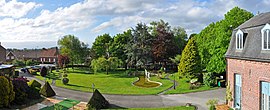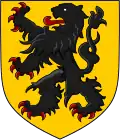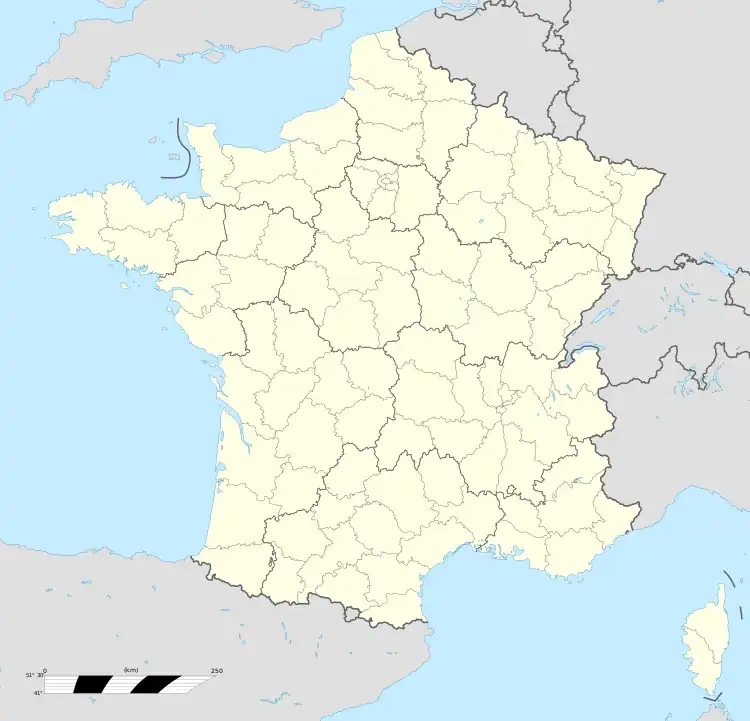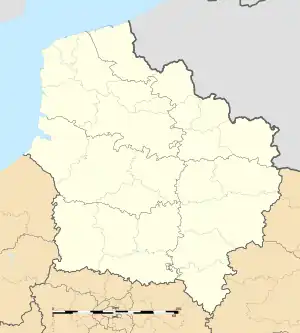Bollezeele | |
|---|---|
 A view within Bollezeele | |
 Coat of arms | |
Location of Bollezeele | |
 Bollezeele  Bollezeele | |
| Coordinates: 50°51′55″N 2°19′29″E / 50.8653°N 2.3247°E | |
| Country | France |
| Region | Hauts-de-France |
| Department | Nord |
| Arrondissement | Dunkirk |
| Canton | Wormhout |
| Intercommunality | Hauts de Flandre |
| Government | |
| • Mayor (2020–2026) | Pierre Marle[1] |
| Area 1 | 17.54 km2 (6.77 sq mi) |
| Population | 1,423 |
| • Density | 81/km2 (210/sq mi) |
| Time zone | UTC+01:00 (CET) |
| • Summer (DST) | UTC+02:00 (CEST) |
| INSEE/Postal code | 59089 /59470 |
| Elevation | 2–52 m (6.6–170.6 ft) (avg. 44 m or 144 ft) |
| 1 French Land Register data, which excludes lakes, ponds, glaciers > 1 km2 (0.386 sq mi or 247 acres) and river estuaries. | |
Bollezeele (French pronunciation: [bɔlzɛl]; from Dutch; Bollezele in the modern Dutch spelling) is a commune in the Nord department in northern France.[3]
It is 17 km (11 mi) south of Dunkirk and also 20 km (12 mi) west of the Belgian border. The river Yser runs through Bollezeele.
Language
Bollezeele's local speech is traditionally a Flemish dialect, similar to that spoken on the other side of the border with Belgium; this led to the town's being included in the Atlas Linguarum Europae as one of the Germanic dialects in France (the others were all in either Alsace or Moselle).[4]
Population
| Year | Pop. | ±% p.a. |
|---|---|---|
| 1968 | 1,389 | — |
| 1975 | 1,328 | −0.64% |
| 1982 | 1,500 | +1.76% |
| 1990 | 1,476 | −0.20% |
| 1999 | 1,382 | −0.73% |
| 2009 | 1,391 | +0.06% |
| 2014 | 1,432 | +0.58% |
| 2020 | 1,424 | −0.09% |
| Source: INSEE[5] | ||
Heraldry
 Arms of Bollezeele |
The arms of Bollezeele are blazoned : Or, a lion sable armed and langued gules. ('Flanders' and the communes of Thourotte, Crépy-en-Valois, Bollezeele, Feignies, Flines-lez-Raches and Wormhout use the same arms.)
|
See also
References
- ↑ "Répertoire national des élus: les maires". data.gouv.fr, Plateforme ouverte des données publiques françaises (in French). 2 December 2020.
- ↑ "Populations légales 2021". The National Institute of Statistics and Economic Studies. 28 December 2023.
- ↑ INSEE commune file
- ↑ Eder, Birgit (2003). Ausgewählte Verwandtschaftsbezeichnungen in den Sprachen Europas. Frankfurt am Main: Peter Lang. p. 299. ISBN 3631528736.
- ↑ Population en historique depuis 1968, INSEE